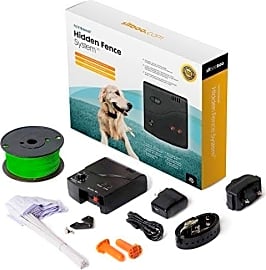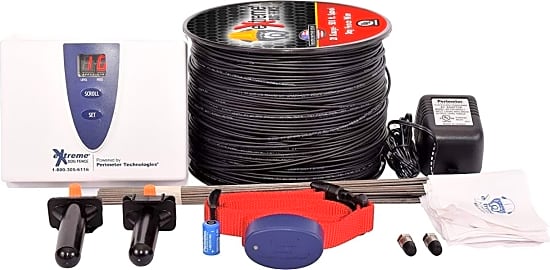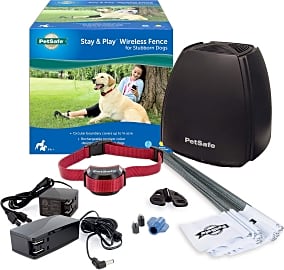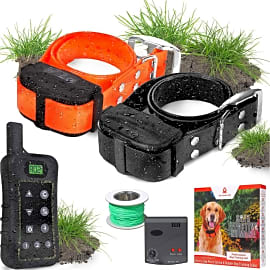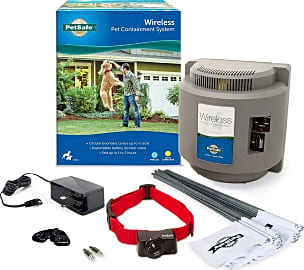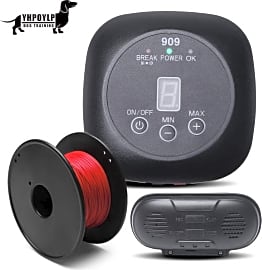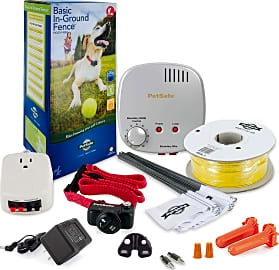The 9 Best Invisible Pet Fences

This wiki has been updated 38 times since it was first published in September of 2015. If you want an alternative to unsightly physical structures or expensive obedience classes when trying to prevent a dog from venturing out of a secure area, try one of these invisible pet fences. With just a little training, they can keep dogs out of harm's way. We've included both wired and wireless containment solutions that act as virtual barriers to keep pets safe. When users buy our independently chosen editorial selections, we may earn commissions to help fund the Wiki.
Editor's Notes
April 02, 2020:
If you're "on the fence" in terms of deciding whether to invest in one of these invisible outdoor containment solutions for your pet, we want to do our best to provide you with realistic options and a good perspective on what these devices can really do. Being a dog owner myself, I'm never thrilled at the idea of providing any sort of discomfort to them, even in the form of light behavioral corrections. But the fact remains that some of us live in rural areas with wide open spaces or in large homes with a lot of land in the backyard. In some of these situations, it's more cost-effective to install an invisible fence than it would be to put up a conventional metal or wood barrier around acres of land. The last thing any pet owner wants to worry about is their beloved four-legged companion getting loose, lost, and potentially harmed as a result. In addition to the use of a shock collar in situations when a dog is incessantly barking, these invisible fences are an equally humane, easy to install, and relatively unobtrusive deterrent when a pup tries to escape. Furthermore, they have useful features to keep Fido as safe as possible. Additionally, we've included choices for particularly stubborn canines who may need some extra training to keep them in check. Now by stubborn, I'm hardly calling dogs stupid. In fact, quite the opposite. I've come to think of stubbornness as a sign of high intelligence with these creatures. As a dog, it takes intelligence to "test" a human in much the same way a young child does with his parents. From experience, I can tell you that one of my pets has me wrapped around her paw, figuratively speaking. Why? Because she knows what I want her to do (and I've seen her do it) but, like human kids, she still likes to test the waters to see how much she can get away with first by pushing the boundary line. That's where our invisible fences can help when it comes to pooches itching to take off on their own adventure without their owners.
The updated SportDog SDF-CT comes with a rechargeable collar that is responsive to both the system's transmitter and the underground wiring when a dog approaches its boundary line. It also comes with 100 training flags, which can provide Fido with visual cues as he learns the rules. Also included is the PetSafe Stubborn Ultimate, which comes with 100 feet of twisted wire that can be used to establish safe crossing points for a dog within the security field. The Sit Boo-Boo Electric uses auto-correct technology to gradually increase the intensity of its static correction as a dog comes closer to the system's perimeter line.
We've also included the Extreme 1D500FT for its frequency encoding capability as well as its temperature check function that maintains a stable security field even if the weather turns nasty.
A relatively new option that we've added is the YHPolyp Wireless. Unlike its counterparts, this system relies on a pet owner's recorded voice to correct a dog's behavior. I like the idea of providing Fido with the sound of a familiar voice (as opposed to static correction) when he approaches a boundary, as it can help reinforce social bonds without forcing the animal to anticipate punishment. While I'm not sure this option could prevent the most determined canine escape artist from bolting, I do think it's a formidable option worth considering for a mild-mannered dog.
Special Honors
SpotOn Virtual Fence Notably more expensive than some other invisible pet containment solutions, the SpotOn Virtual Fence doesn't use any base stations or buried wires. Instead, the system leverages GPS technology that allows you to walk, establish, and save up to 10 custom perimeters of any shape or size. Automatic tracking is provided to within 10 feet of a pet's location. Its companion mobile app supports the naming, activation, and deactivation of custom boundary maps, while also allowing you to see your dog's location at the touch of a button. You can also receive escape notifications and automatically track your dog from a mobile device if she leaves the safe zone. spotonfence.com
Dog Forum Having been around since 2008, the Dog Forum is an online community consisting of pet owners who share their lives with all breeds of canine and discuss a variety of topics, including training, behavior, health, and food as well as asking questions and seeking advice on matters pertaining to their four-legged companions. The forum currently has well over 450,000 posts and 45,000 members. dogforum.com
Maintaining Fido's Safety With Peace Of Mind
To your pooch, it takes the form of a light tickle or vibration, not a dangerous electric shock.
A wireless pet fence creates an invisible circular boundary around a central base station using radio waves to keep your pet from wondering off. Most wireless pet fence solutions come with a transmitter and receiver. The transmitter acts as the main base station, which plugs into an indoor power outlet in your home or garage. The transmitter emits an omnidirectional radio wave signal within a certain radius that can range anywhere from thirty feet to several acres of coverage.
The area inside this circular boundary is referred to as the safe zone in which your pet will be free to roam. The receiver usually takes the form of a pet collar and it picks up the signal coming from the transmitter. As long as the receiver is picking up the signal from the transmitter, your dog is free to roam within the safe zone. When he or she approaches the outer perimeter of the safe zone, the collar emits an audible warning beep.
Should the dog continue to move out of the safe zone (farther away from the transmitter), then the dog will experience a non-harmful form of static correction, alerting them not to proceed any further. With training, your dog learns to move away from the outer boundaries of the safe zone when hearing the warning beep, so the idea is that the static correction occurs less frequently over time.
You might be thinking that static correction is painful or dangerous. To your pooch, it takes the form of a light tickle or vibration, not a dangerous electric shock. Furthermore, many pets are quite sensitive to noise, thanks to their well-developed sense of hearing. For that reason, they're more likely to learn how to respond to an audible stimulus before the static correction over time. The good news is that many wireless fence systems provide the ability to adjust the level of the receiver's static correction your dog receives (no level being harmful), but the idea is that your pet is eventually trained to avoid getting that far in the first place.
The wireless pet fence system often comes with additional training tools that include flags, which can be placed around the boundary of the safe zone. When used as visual cues in combination with the beep alert, these flags quickly teach your pet to associate them with the alert from the receiver collar. The pet can then be trained what to do when they approach these flags.
The Best Invisible Protection
In addition to maintaining a dog's health, giving them plenty of love and affection, and proper feeding, safety is of equal importance. Depending on how large your property is, the last thing you want is for your furry friend to go roaming into the neighbor's yard where he doesn't belong or out into the street where it's dangerous. There may be a number of underlying causes behind why your pooch constantly escapes from your property. For that reason, you'll want to ensure that your pet has a place where he can enjoy the outdoors with less of a reason to go exploring.
Perhaps the most important consideration for a wireless pet fence is the range of its transmitter and the coverage area for the safe zone.
Additionally, you don't want your pet to feel as though he's a prisoner, which a conventional fence might suggest. Also, fences that appear overbearing may actually encourage the very behavioral inconsistencies you are trying to prevent by erecting a fence in the first place. Containment without a ton of wires or rusty metal all around your property is possible using a wireless pet fence and containment system.
Perhaps the most important consideration for a wireless pet fence is the range of its transmitter and the coverage area for the safe zone. While there is no need to invest in a solution that offers a much larger range than you actually need around your property, it's great to find one that can provide up to several acres of coverage anyway. This can come in very handy if you desire to travel with your pet.
Part of the benefit to a wireless pet fence is its ability to be installed anywhere that you can find an available outlet. That way, you can keep an eye on your dog even when you take him on vacation with you. Unfortunately, you just can't do that with a traditional fence or one that still requires the installation of a physical wire in the ground to mark a boundary.
Consider the receiver collar that comes with your wireless fence system. It should be waterproof, with several adjustable levels of static correction, and capable of holding a good charge for at least several hours. Ideally, you want the dog to associate a sound with a reminder to stay close without depending on a physical vibration to startle them.
A Brief History Of Wireless Pet Fences
Traveling salesman Richard Peck is credited as the inventor of one of the first pet containment systems in the early 1970s, referred to as the Stay-Put. Peck's decision to invent the system came from his innate love for dogs and the frustration he experienced when seeing pets on the road with the potential for being injured.
Traveling salesman Richard Peck is credited as the inventor of one of the first pet containment systems in the early 1970s, referred to as the Stay-Put.
Similar to the way modern wireless pet fences operate, three components made up Peck's system and included a transmitter box (mounted indoors), a wireless receiver collar for the dog, and a wire placed around a pet owner's home to mark the boundary. This final component marked the fundamental difference between Peck's original design and today's variety of wireless fences that don't require the use of an in-ground boundary wire. Peck also formed the Stay-Put Sales Company through which he marketed this product using direct mail and magazines.
In 1976, Peck sold the marketing and patent rights for his invention to John Purtell, who took the idea and formed the Invisible Fence Company. Purtell lost exclusive rights to Peck's invention when the patent rights expired in 1990. This allowed for the growth of additional companies and competition to enter the market for the development of both in-ground and wireless pet containment systems using radio signals to operate, many of which continue to be popular today with pet owners who are always on the go.



